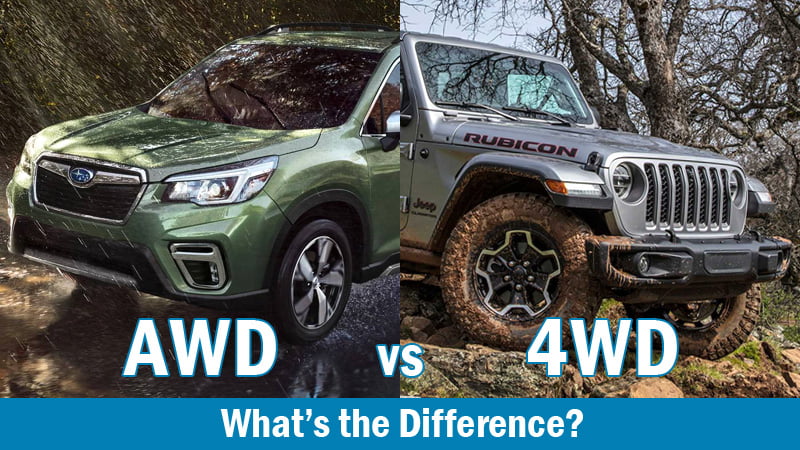AWD vs 4WD vs FWD: What is the difference explained

AWD – All-wheel drive and 4WD – four-wheel drive are both systems that power all four wheels of a vehicle, but they have different mechanisms and purposes. Here are some of the main differences between them:
- All-wheel drive (AWD) is a full-time system that always connects all four wheels to the source of power and can rotate them at different speeds¹. AWD offers great traction and road grip on slippery, muddy, or loose surfaces¹. AWD systems generally operate with no input from the driver, although some offer selectable modes that allow a degree of control over how much power goes where. AWD is better suited for on-road conditions, especially in bad weather. AWD costs more than two-wheel drive and reduces fuel economy.
- Four-wheel drive (4WD) is a part-time system that mechanically engages the drive to all four wheels by a driver-selectable system or a transfer case¹. 4WD is ideal for extreme off-road driving conditions, such as rocky terrain, steep hills, and deep water¹. 4WD systems typically allow drivers to manually lock the front and rear axles together for better traction³. 4WD allows more towing capability than AWD⁶. It’s not wise to use 4WD on anything but slippery, loose, or rugged surfaces, as it can damage the drivetrain or cause handling problems.
What Is The Difference Between AWD and 4WD In Terms Of Fuel Economy?
The difference between AWD and 4WD in terms of fuel economy is that AWD generally reduces fuel economy more than 4WD, especially if it is a full-time system that cannot be turned off. This is because AWD systems add more weight and complexity to the vehicle, and they create more friction and drag in the drivetrain. According to Edmunds, the average fuel economy penalty for AWD is about 1-2 mpg compared to a similar 2WD vehicle.
However, some AWD systems are more efficient than others, depending on how they operate and what features they have. For example, some AWD systems have a rear-axle disconnect feature that physically disconnects the transmission from the rear wheels until additional traction is needed, which improves fuel economy. Some AWD systems are also part-time or automatic, meaning they only engage all four wheels when necessary, which also saves gas.
4WD systems can also affect fuel economy, but they usually have less impact than AWD systems because they can be turned off when not needed. This allows the vehicle to operate in 2WD mode most of the time, which reduces weight, complexity, friction and drag. However, 4WD vehicles tend to be heavier and less aerodynamic than AWD vehicles, which also lowers their fuel efficiency³. According to Edmunds, the average fuel economy penalty for 4WD is about 0.5-1 mpg compared to a similar 2WD vehicle.
Which one is better for snow driving, AWD or 4WD?
Both AWD and 4WD can improve traction and handling in snow and ice, but they have different advantages and disadvantages depending on the driving conditions and the type of system.
- AWD is better for driving on snowy and icy roads that are ploughed frequently or have a thin layer of snow¹². AWD offers more consistent grip and stability on slippery surfaces and does not require any input from the driver. AWD is also more fuel-efficient and economical than 4WD.
- 4WD is better for driving in extreme snow and off-road situations, such as deep snow, icy inclines, or rocky terrain. 4WD offers more traction and torque in the most demanding conditions and allows the driver to manually lock the front and rear axles together for better grip. 4WD also allows more towing capability than AWD.
- However, 4WD is not suitable for driving on dry or wet pavement, as it can damage the drivetrain or cause handling problems³⁵. 4WD also uses more fuel and costs more than AWD. 4WD requires the driver to stop the vehicle and shift gears to engage or disengage the system.
Also Read: Cab Taxi Business In Nigeria
In summary, AWD and 4WD are both useful for winter driving, but they have different strengths and weaknesses. The best option depends on your personal needs, driving habits, and winter tires. If you are looking for a vehicle with AWD or 4WD, you may want to check out some of the models that are good for snow driving, such as:
Can I use AWD or 4WD on dry pavement?
The answer to your question depends on whether you have a part-time or a full-time AWD or 4WD system in your vehicle. Here are some general guidelines:
–Part-time AWD systems can be used on dry pavement, as they only engage all four wheels when necessary, such as when the vehicle detects a loss of traction. However, some part-time AWD systems may have a manual or automatic mode that locks the front and rear axles together, which should not be used on dry pavement.
–Full-time AWD systems can also be used on dry pavement, as they have a centre differential or a clutch system that allows the front and rear wheels to rotate at different speeds and prevent drivetrain binding. However, some full-time AWD systems may have a lock mode that bypasses the centre differential, which should not be used on dry pavement.
–Part-time 4WD systems should not be used on dry pavement, as they lock the front and rear axles together and cause drivetrain binding, which can damage the drivetrain or cause handling problems. Part-time 4WD systems should only be used on slippery, loose, or rugged surfaces, such as snow, mud, sand, or gravel.
–Full-time 4WD systems can be used on dry pavement, as they have a centre differential that allows the front and rear wheels to rotate at different speeds and prevent drivetrain binding. However, some full-time 4WD systems may have a lock mode that bypasses the centre differential, which should not be used on dry pavement².
In summary, AWD systems are generally safe to use on dry pavement, unless they have a lock mode that should be avoided. 4WD systems are generally not safe to use on dry pavement unless they have a centre differential that allows them to operate like an AWD system. You should always check your owner’s manual for specific instructions and warnings about your vehicle’s AWD or 4WD system. I hope this helps you understand the difference between AWD and 4WD and how to use them properly.
Can I switch from AWD to FWD while driving?
Other AWD systems are part-time or automatic, meaning they only engage all four wheels when necessary, such as when the vehicle detects a loss of traction¹. These systems may have a switch or a mode that allows the driver to manually select AWD or FWD, or they may do it automatically without any input from the driver¹. For example, some vehicles have a rear-axle disconnect feature that physically disconnects the transmission from the rear wheels until additional traction is needed, which improves fuel economy.
If your vehicle has a part-time or automatic AWD system, you may be able to switch from AWD to FWD while driving, depending on the design and instructions of the system. You should always check your owner’s manual for specific details and warnings about your vehicle’s AWD system and how to use it properly. Some general tips are:
– Do not switch from AWD to FWD while accelerating, braking, cornering, or driving on slippery surfaces, as this may cause instability or damage to the drivetrain.
– Do not switch from AWD to FWD if your vehicle has a lock mode that locks the front and rear axles together, as this may cause drivetrain binding or handling problems on dry pavement.
– Do not switch from AWD to FWD if your vehicle has a different tire size, pressure, or tread wear on the front and rear wheels, as this may affect the performance and safety of the system.
What is 4WD?

4WD is a system that powers all four wheels of a vehicle, either full-time or part-time. 4WD is typically used for off-road driving conditions, where it provides more traction and torque than two-wheel drive. 4WD vehicles usually have a transfer case that allows the driver to switch between 2WD and 4WD modes, or a lock mode that locks the front and rear axles together for better grip.
Also Read: Mercedes Benz MayBach 2023 Reviews | Prices and Features
2023 Lamborghini Urus Spec – Features and Price Reviews
There are different types of 4WD systems, such as:
– Part-time 4WD – This system can be turned on and off by the driver, usually by a lever or a button. It should only be used on slippery, loose, or rugged surfaces, such as snow, mud, sand, or gravel. It should not be used on dry or wet pavement, as it can damage the drivetrain or cause handling problems.
– Full-time 4WD – This system is always active and does not require any input from the driver. It has a centre differential that allows the front and rear wheels to rotate at different speeds and prevent drivetrain binding. It can be used on any type of surface, both on- and off-road. Some full-time 4WD systems also have a lock mode that bypasses the center differential for better traction in extreme conditions.
What is different between AWD, FWD and 4WD?
The difference between 4WD, FWD and AWD is the way the engine’s power is distributed to the wheels of a vehicle. Here is a brief summary of each system:
– 4WD stands for four-wheel drive and is a system that powers all four wheels of a vehicle, either full-time or part-time. 4WD is typically used for off-road driving conditions, such as snow, mud, sand, or gravel, where it provides more traction and torque than two-wheel drive. 4WD vehicles usually have a transfer case that allows the driver to switch between 2WD and 4WD modes, or a lock mode that locks the front and rear axles together for better grip.
– FWD stands for front-wheel drive and is a system that powers only the front wheels of a vehicle. FWD is the most common drivetrain system in modern cars, as it is cheaper, lighter, and more fuel-efficient than other systems. FWD also offers better traction and stability on slippery surfaces, as the weight of the engine helps push the front wheels down. However, FWD can also cause understeer, torque steer, and reduced steering feel.
– AWD stands for all-wheel drive and is a system that powers all four wheels of a vehicle, either full-time or on-demand. AWD can improve traction and handling in low-traction driving conditions, such as snow, mud, sand, or gravel, but it also depends on the type of tires and the specific capabilities of the vehicle.
AWD vehicles usually have a center differential or a clutch system that allows the front and rear wheels to rotate at different speeds and prevent drivetrain binding². AWD vehicles tend to be lighter and more fuel-efficient than 4WD vehicles.





